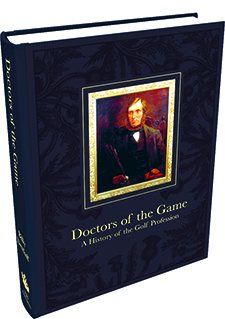
Reviewed by Jim Davis
When an esteemed PGA professional such as Billy Detlaff places the results of seven years labor in front of one and says have a go, well…
I was frankly astonished at the amount of material produced here. The book before us is no less than a definitive (believe me, that word entirely fits) volume charting the long history of the golf professional, beginning with “The Undefeated” himself, Allan Robertson, and that young protegé of his, an up-and-comer named Tom Morris.
Detlaff himself is the son of a Doctor of the Game, Henry Detlaff, who built and managed Oskosh’s Lakeshore Municipal Golf Course for some 35 years. The elder Detlaff taught golf champion Johnny Revolta and helped grow the game in Oskosh. Young Billy worked on the course on the maintenance crew, and as a caddy before studying journalism in college and spending five years in the tough world of Chicago newspapers.
Detlaff finally realized his dream of a golf career and served as head pro at the Inverarry Country Club in Lauderhill, Fla. He later earned a designation as a PGA Master Professional and has served as director of golf and general manager for the PGA Tour’s TPC Network, which included overseeing such properties as TPC Sawgrass.
His passion for golf history and for the golf profession has combined nicely in this beautiful volume, timed to publish during 2016, the year of the PGA’s 100th anniversary
Wally Uihlein, in his foreward to the book, writes that Detlaff has created “essential reading for the present and future custodians of the game. It is a living, breathing gift to golf history, a manual to preserve, and protect the game…”
Comprehensive is a near understatement when considering this work and its presentation of the golf pro’s journey from 1836 and the great Allan, to the present day Doctors of the Game. All told, more than 100 of these golfing physicians are presented, their stories told with a care and affirmation of that sense of custodianship of a game, a passion, unlike any other.
The 120 biographies and profiles are complemented with some 335 photographs and period engravings.
One cannot sit down with this book and devour it over a few sittings. Its strength is in its detail, its span of history and the individuals and developments that comprise that history. Rather, one selects from a menu of three main courses and their accompanying sub-menus and enjoys over time the superlative dishes therein offered.
Book One lays out the Scottish Revolution from the origins of the game and early play, through equipment evolution and the development of the early professional, ending with a description of Willie Park Junior and that man’s legendary gifts to the game.
Book Two explores the American Transformation of the game, including the immigration of so many Scottish professionals eager to teach the golfing gospel to America’s burgeoning numbers of golfing addicts. Each PGA pro’s story is given with an eye toward a portrait of the whole. His/her life and golfing accomplishments are told from the perspective of a professional writing about professionals.
In Book Three, a summation of how the game has changed since 1850 and its growing influence in the New World through World War I are examined with particular emphasis on the growing influence of the PGA pro, by now a recognizable force in the game’s growth.
This section represents Detlaff’s clearest affection for his fellow professionals, many of whom he has known and personally worked with. The many profiles shared here, from the unsung ranks of club pros to those who have attained great fame, are a portrait of a family with a shared dedication to the continuance of a long tradition as Doctors of the Game.
From Jim Barnes and founding of the PGA of America’s in 1916, Detlaff traces the evolution of the ball, the clubs, the professionals, the events, and the exciting developments in golf that have resulted in nearly every civilized person on the planet knowing something about this game.
As with any book of this magnitude (the book and slipcover weigh 9 pounds), organization is paramount if the researcher, or reader, is to benefit and Detlaff has done due diligence.
The large page size, 9-by-12, is complemented by spacious leading and a readable font so that there is no appearance of crowding despite the wealth of information.
PGA profiles and the myriad items of golf history are readily found and easily read. Even the index, a massive chore given the scope of the undertaking, is well done, to the relief and joy of the grateful researcher.
Throughout, Detlaff’s passion for the game, his sense of golf history and the place in it which this volume must necessarily assume as an important summation of PGA history itself, is keenly felt and appreciated.
Doctors of the Game is a stunning achievement, a work this reviewer is honored to own and to which he will no doubt return time and again for authoritative information on golf history and the PGA professionals who are as the ancient game’s DNA and will transmit to future generations the knowledge and love of this surely timeless sport.
